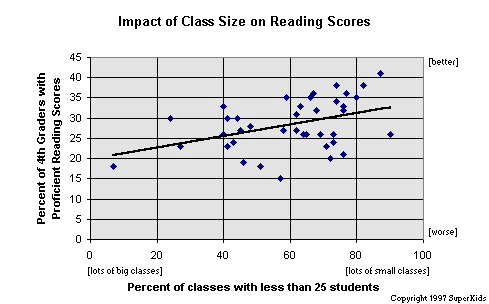

"Kids can't read!" "Test scores are too low!" "Scores continue to drop!" The headlines scream. And everyone seems to agree that we need to do something about the problem.But what should we do? Is the problem with the educational "system" or with our society? Since the latter is tough to quantitatively measure, we thought we'd take a look at the educational system, using data from the most recent NAEP (National Assessment of Educational Progress) tests on Reading skills, and information presented in Education Week's recent special report on the state of public education in America, "Quality Counts."
One of the most commonly named culprits in the decline of the American education system is class size. Too many students for too few teachers, it is claimed, creates an environment that can better be called "day-care" than education.
In his 1998 State of the Union address, the President proposed a $12.4 billion initiative to reduce class size in grades 1-3 to a nationwide average of 18 students.
It seems logical - smaller class sizes would allow for greater individual attention by the teacher. But does it really make a difference? And if it does, how big a difference? (Class size is also a useful measure to study because it is generally correlated with per pupil spending, yet doesn't require adjustments for regional cost of living differences.)
The graph below shows each state, based on:
- the percent of 4th graders with proficient reading scores, and
- the percent of elementary classes with less than 25 students per teacher.

Click on image for supporting data and analysisPoints toward the upper right corner of the graph represent states with better reading scores and more small classes; points toward the lower left corner are for states with lower reading scores, and more large classes.
What does it all mean? Based on this one nationwide snapshot in time, it is clear that class size has an impact. (In statistical terms, there is a positive correlation between class size and test scores, as seen in the sloped line plotted on the graph.)
How big an impact? Based solely on the data presented here, if the nationwide percentage of elementary classes with fewer than 25 students was raised from 53% to 75%, we would expect the percentage of proficient readers to move from 28% to 31.2%.
Want to see more information on how your state compares? Check out our report on How the States Stack-Up.



 Reviews /
Contents /
Sponsors /
Help
Reviews /
Contents /
Sponsors /
Help
Questions or comments regarding this service?
webmaster@superkids.com
Copyright © 1997, 1998 Knowledge Share LLC.
All rights reserved.